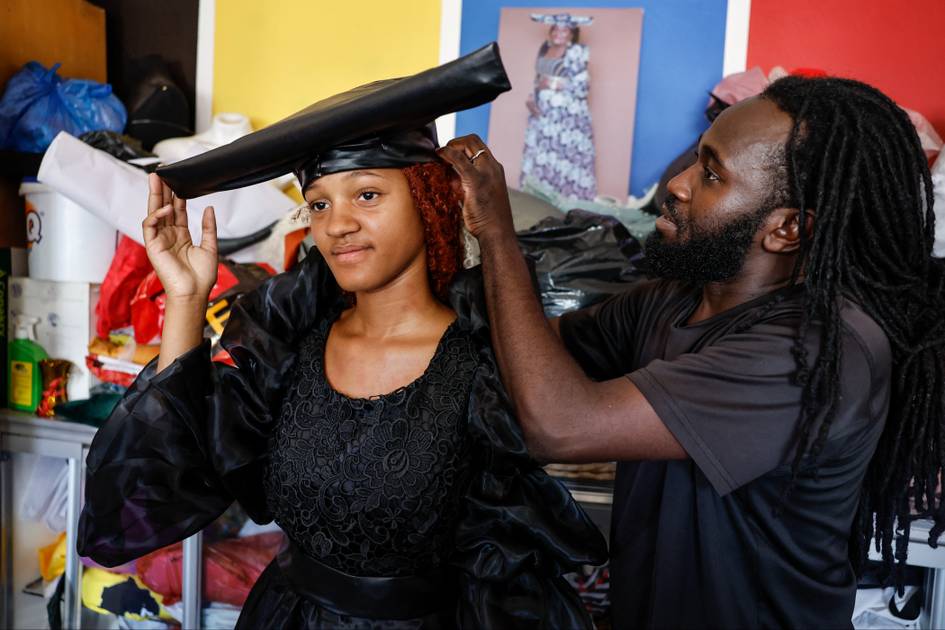Windhoek, Dec 18, 2024 (AFP) – From his humble Windhoek workshop, Namibia’s
leading fashion designer is keeping alive the love for the Herero people’s
traditional dress with horned headgear, a full-length skirt and a link to
German colonisers accused of genocide.
McBright Kavari’s sewing room is piled high with seemingly ordinary fabric
that he transforms with labour and skill into elegant and voluminous dresses
called ohorokova.
Kavari’s designs may introduce modern twists, but they maintain the
distinctive and conservative character of a garment believed to have its roots
in the arrival of German missionaries in this arid southwestern African land
in the early 19th century.
“Myself being a Herero, I felt like that to keep the dress alive, I have to
think outside the box and modify it and make it lovable for the youth and the
young generation,” he told AFP.
Kavari always includes one or two ohorokova outfits in his collections. His
creations have walked runways in China, Ethiopia, Ghana and even Germany, the
former colonial power that historians say committed the first genocide of the
20th century against the Herero and Nama, another of Namibia’s ethnic groups.
“I want to show it (the ohorokova) to the world to tell more people about
our Herero people,” he said. “Once it’s on stage, it wows everybody. Everybody
wants to know more about it. It’s very attached to history as well.”
The German occupiers are believed to have killed at least 60,000 Herero
between 1904 and 1908, about 80 percent of the population at the time, in
outright massacres or by locking them into concentration camps. About 10,000
Nama people also died.
It is not certain how Herero women came to adopt the ohorokova, replacing
the long, hide aprons that they wore before, but the dress has endured despite
the passage of time and its links to German colonisation.
“We don’t know if it was a choice to adopt that dress, or if it happened by
force,” said Maria Caley, fashion lecturer at the University of Namibia.
But it carried through the traditional values of the Herero people, such as
that a woman should cover her body and not even show her knees, Caley said.
And the Herero version of the dress is “completely different” to that of
the first missionaries, having been adapted and appropriated to represent the
Herero people, she said.
Horned headdress
Perhaps the most striking piece of the outfit is the headdress, called
otjikaiva, which resembles the horns of a cow, reflecting the Herero roots as
cattle herders.
“The headdress used to be very plump and chunky, not so wide from the
head,” Caley said. “But now it has become very thin and very, very stylized.”
This is only one of Kavari’s innovations. Some of his designs have added
several layered petticoats to the floor-length skirts, or abandoned the
sleeves.
He caused an outcry with a design in 2013 that featured a snake in the
headdress of a creation for the country’s Miss Universe contender.
“The journey hasn’t been that easy,” said the designer. “People are not
easy when it comes to change.”
“Non-negotiables” are the length of the skirt and conservative neckline,
said one of his top customers, Yamillah Vetarapi Katjirua, who owns about 50
creations from flesh-coloured to aquamarine and lapis lazuli.
“He has been able to maintain the integrity of the dress but still make it
modern so that young people don’t disassociate from it,” she said. “For me he
has struck that balance very well between modernising and respect.”
That so many people have an opinion on the dress shows that this aspect of
the Herero culture is still “very much alive”, said Caley.
The Herero are a relatively small group: only around 179,000 remain, less
than six percent of Namibia’s population, according to the 2023 census.
“I feel they fell in love with the dress, they are more in love with the
dress,” Kavari said. “Every young Herero lady is owning one or two dresses in
their closet.”
By taking his designs from one of the world’s most sparsely populated
countries to international catwalks, Kavari said he wants “to keep the people
aware that there is a tribe in Namibia, the Herero-speaking people”.(AFP)







